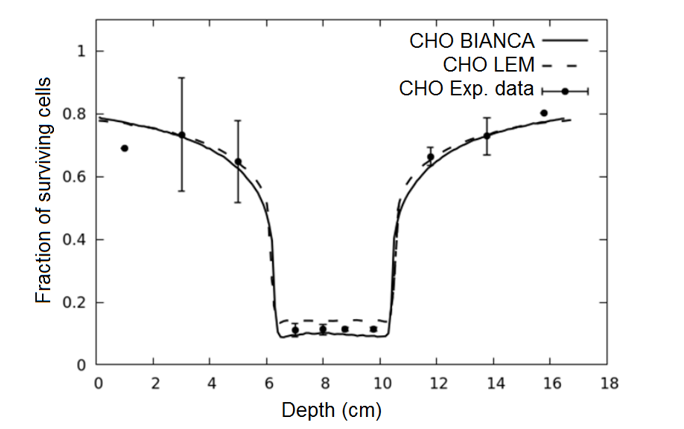Development of FLUKA for radiobiological studies and particle therapy range verification

OMA fellow based at CERN Giulia Aricò has recently published two articles in Physics in Medicine and Biology, summarising her research on the modelling of radiobiological effects in hadron therapy, and FLUKA production cross sections of PET isotopes for particle therapy range verification.
Compared with conventional radiotherapy, charged particles offer a better dose localization. Moreover, heavy ions have a higher biological effectiveness, which makes them particularly advantageous for treating radio-resistant tumours.
The biological effectiveness of a given ion is usually expressed in terms of the Relative Biological Effectiveness (RBE), defined as the ratio between the photon and the ion dose needed to obtain the same biological effect (in vitro cell survival). RBE in heavy ions is a complex quantity that depends on physical and biological parameters. Due to these dependencies, the RBE of heavy ions requires the development of appropriate models.
In one of the articles published in Physics in Medicine and Biology, a biophysical model developed in Pavia, called BIANCA, was extended up to oxygen ions and systematically tested against experimental data for V79 cells (a cell line from Chinese hamster lungs) irradiated by different types of ions. This allowed the authors to build a radiobiological database describing the survival of V79 cells, considered as a reference cell line. Using this database as a reference, a method was developed to perform full predictions of RBE for any cell line of interest.
BIANCA was then combined with the radiation transport code FLUKA in order to predict cell survival in typical patient treatment scenarios.
The model predictions were found to be in good agreement with Chinese hamster ovary cells survival data obtained at the Heidelberg ion-therapy centre, as well as predictions performed by the Local Effect Model.
This work showed that BIANCA can be used for cell survival and RBE predictions in any cell line of interest. Furthermore, BIANCA was able to predict cell survivals in relevant treatment scenarios, which represent a starting basis for future clinical applications.
The second article reports the measurement of cross sections for the production of the PET isotopes 10C, 11C and 15O from carbon and oxygen targets induced by protons (40–220 MeV) and carbon ions (65–430 MeV/u). The data were obtained via activation measurements of irradiated graphite and beryllium oxide targets using a set of three scintillators coupled by a coincidence logic.
The measured cross sections are relevant for the PET particle range verification method where accurate predictions of the b¬+ emitter distribution produced by therapeutic beams in the patient tissue are required. The presented dataset is useful to improve and validate the FLUKA nuclear reaction parametrization, as well as as reference for other Monte Carlo codes.